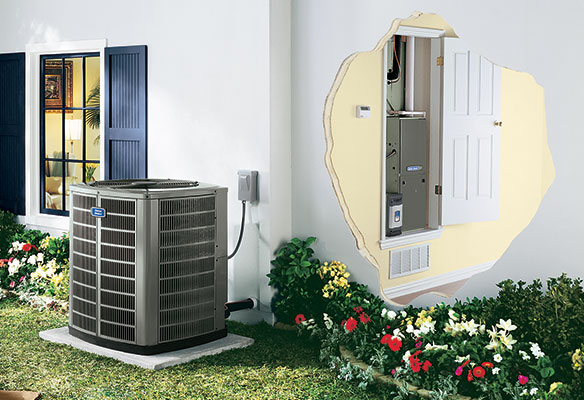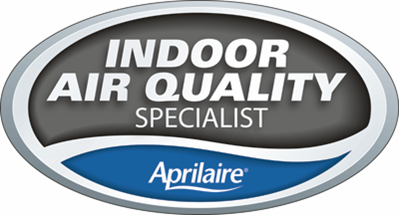
Home HVAC System
You are viewing a typical split system air conditioner and furnace configuration found in most Toledo homes. This split system also features optional advanced indoor air quality products.
See below for a detailed description of how an air conditioner (or heat pump) and gas furnace work together to provide comfort for your home.
For fast Toledo air conditioning repair or heating repair service for your home, call Calverley Heating & Cooling at (419) 740-2003 today!
- Refrigerant is cooled. Once the thermostat registers that indoor air is too warm, the air conditioner (or heat pump) kicks in and compresses refrigerant. Compressing refrigerant releases the heat and chills it. The chilled refrigerant is sent back inside to the indoor coil, typically called an evaporator coil. The efficiency of an air conditioner or heat pump (cooling) is measured with a Seasonal Energy Efficiency Rating (SEER).
- Fan pulls air from the home. The furnace fan or fan coil (air handler) pulls air from the home through the return air duct. Yes, even in the cooling season, your furnace is used. A variable speed fan offers quieter, more efficient operation.
- Air is filtered. Return air is filtered before entering the air conditioning system. Advanced air cleaners can filter microscopic particles and viruses out of the air keeping your home healthy and your system very clean which helps with efficiency and reliability.
- Air is cooled. The filtered air is then pushed through the coil system by the fan motor. The cold refrigerant in the evaporator coil absorbs heat and causes moisture to condense, thus cooling and dehumidifying the air. This conditioned air is pushed on by the fan while the heated refrigerant is sent back outside to the air conditioner (or heat pump). The heated refrigerant is pressurized again to remove the heat.
- Mold is killed & coil efficiency kept high. In the damp interior of an evaporator coil, mold will grow which affects not only the health of your family (mold spores in the air), but the efficiency of your system. In the example layout above, a UV lamp is mounted within the coils to prevent this. UV light kills mold keeping your system efficient and healthy.
- Cooled air sent back into the home. After leaving the evaporator coil, the cool, dehumidified air is pushed back into the home. In extremely humid climates, a separate whole house dehumidifier can be installed to further remove humidity from the conditioned air.
- Air is exchanged. At the top left of the above system layout sits a ventilator. Ventilators are part of complete indoor air quality solutions. They exchange fresh outdoor air for stale indoor air. A ventilator is able to do this with minimal loss of energy, retaining the cooled and dehumidifed air your Air Conditioning system worked hard to produce!
The Split System Heating Process:
Gas Furnace:
- Heat exchanger is heated. A heat exchanger is a type of metal grid that air passes through, and it is heated by the gas powered flames once the thermostat registers indoor air as being too cold.
- Fan pulls air from the home. The fan in your system pulls air from the home through the return air duct. A variable speed fan is quieter, more efficient and provides a more comfortable climate.
- Air is filtered. Return air is filtered before entering the system. Advanced air cleaners can filter microscopic particles and viruses out of the air keeping your home healthy and your Air Conditioning system very clean which helps with system life and efficiency.
- Air is heated. The air is then pushed over the heat exchanger by the fan motor.
- Humidity is added back. A heat exchanger dries out winter air even more. A whole home humidifier replenishes needed moisture for a healthier home. Restored humidity also helps the air feel warmer, thus decreasing the energy needed during the winter to feel warm and comfortable.
- Heated air sent back into the home. The fan forces the heated air back into the home via installed ductwork.
- Air is exchanged. At the top left of the above system layout sits a ventilator. Ventilators are part of complete indoor air quality solutions as they exchange fresh outdoor air for stale indoor air. A ventilator is able to do this with minimal loss of energy, retaining the warm, humidified air your system worked hard to produce!
Heat Pump:
- Heat Pump is engaged: When the thermostat registers the need for warm air the heat pump turns on and begins extracting heat energy from the outside air. Even when it is cold outside, air contains a certain amount of heat energy. A heat pump absorbs this energy into the refrigerant, and then sends the heated refrigerant back inside.
- Fan pulls air from the home. The fan in your fan coil (air handler) pulls air from the home through the return air duct.
- The air is filtered. As with the first method, an advanced air cleaner filters out micro scopic dust and organisms.
*Coil difference: When using a furnace and air conditioner, the indoor coil is separate, and called an evaporator coil. When using a heat pump only, the indoor coil is called a fan coil, and is basically a combination of the furnace fan and the evaporator coil.
- Air is heated. The air is then pushed through the coil system by the fan motor. The heated refrigerant warms the passing air and then is cycled back outside to the heat pump.
- Mold is killed & coil efficiency kept high. In the damp interior of an evaporator coil, mold will grow which affects not only the health of your family (mold spores in the air), but the efficiency of your system. In the example layout above, a UV lamp is mounted within the coils to prevent this. UV light kills mold keeping your system efficient and healthy.
- Heated air sent back into the home. After leaving the indoor coil, warm air is pushed back into the home. In dry winter climates, a separate whole house humidifier can be installed to replenish the humidity in indoor air.
- Air is exchanged. At the top left of the above system layout sits a ventilator. Ventilators are part of complete indoor air quality solutions. They exchange fresh outdoor air for stale indoor air. A ventilator is able to do this with minimal loss of energy, retaining the cooled and dehumidifed air your system worked hard to produce!
Hybrid Heating System:
- A hybrid system uses both a furnace and a heat pump. Heat pumps can be more efficient than a gas furnace at certain temperatures in areas where fuel prices are high. Heat pumps cannot provide adequate heat however in extreme cold, and their efficiency drops substantially at that point.
- A smart thermostat is used to control a hybrid heating setup. It intelligently switches between units for the highest energy efficiency available depending on the outside temperature.
We provide maintenance and repair for all makes and models including:

















































